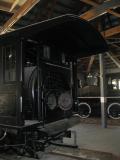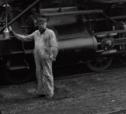
| Home | Open Account | Help | 370 users online |
|
Member Login
Discussion
Media SharingHostingLibrarySite Info |
Steam & Excursion > Late 19th Century CamelbacksDate: 03/31/21 17:08 Late 19th Century Camelbacks Author: MacBeau Among the treasures of the Detroit Photographic Company sequestered in the Library of Congress are numerous scenes of late 19th early 20th Century steam. Offed as an example is this image taken in Scanton, Pennsylvania. The LOC gives a date range of 1890-1901, but the builder's date of 1898 on this Brooks 4-8-0 narrows that down more than a little. Interesting minor difference between the two in class light placement.
Be of good cheer, —Mac www.lowellamrine.com Edited 1 time(s). Last edit at 03/31/21 18:19 by MacBeau.  Date: 03/31/21 17:45 Re: Late 19th Century Camelbacks Author: EMD2024 It looks more like a 4-8-0 to me. A pilot wheel is behind the cylinder.
MWPerkins Posted from Android Date: 03/31/21 18:02 Re: Late 19th Century Camelbacks Author: wcamp1472 Agreed..
4-8-0.... W. Date: 03/31/21 18:18 Re: Late 19th Century Camelbacks Author: MacBeau Bad eyes, thanks for the catch. Looked at the builder's date too much.
—Mac EMD2024 Wrote: ------------------------------------------------------- > It looks more like a 4-8-0 to me. A pilot wheel is > behind the cylinder. > > MWPerkins > > Posted from Android Date: 03/31/21 19:03 Re: Late 19th Century Camelbacks Author: patd3985 I could never figure out the reason for the "Camelback" locomotive design. It would seem to me that the fireman would like to see what the Engr. was doing and vice-versa! And if nothing else, have someone to talk to. ( Any Camelback experts & admirers are welcome to chime in here with their explanations.) Thanx,..............Pat
Date: 03/31/21 19:08 Re: Late 19th Century Camelbacks Author: SeaboardMan Notice that there are no tie plates but a cool photo.
john Date: 03/31/21 19:33 Re: Late 19th Century Camelbacks Author: rkennedy2 Think the design was becuase of the giant Wooten firebox dimensions. The large grate area.
Date: 03/31/21 22:18 Re: Late 19th Century Camelbacks Author: ajax247 That's a great picture!
Date: 04/01/21 07:48 Re: Late 19th Century Camelbacks Author: atsf121 ajax247 Wrote:
------------------------------------------------------- > That's a great picture! Agreed Posted from iPhone Date: 04/01/21 09:53 Re: Late 19th Century Camelbacks Author: LarryDoyle patd3985 Wrote:
------------------------------------------------------- > I could never figure out the reason for the > "Camelback" locomotive design. It would seem to me > that the fireman would like to see what the Engr. > was doing and vice-versa! Do Not feel sorry for the fireman of a Camelback. They had EXACTLY the same accomodations as the fireman on 'most any other locomotive built in the last quarter of the 19th century, as evidenced by this photo of a typical "Deckless Cab" engine of the period. In both cases the firemans working position is out in the open, standing on the deck of the front of the tender. And, the anthricite these engines burned was not as demanding to fire as the bituminus used on narrow firebox engines. > And if nothing else, > have someone to talk to. There's not a lot of idle chatter in a steam locomotive cab. Too noisy. But it's a NICE noise. -LD  Date: 04/01/21 11:16 Re: Late 19th Century Camelbacks Author: wcamp1472 Later camelbacks, with ‘butterfly’
fire doors, were fitted with two sets of fire doors. Anthracite fires do NOT spread laterallly... to be successful you gotta add new fuel directly on the embers... So, reaching the rear corners of the grates, was difficult on camelbacks. The 2 sets of ‘doors’ made reaching the rear corners more easily. ( Butterfly fire doors had pivot pins at the top, and the two doors swung apart by almost 50 degrees, angle. They were air -cylinder, pressure operated, with a foot treadle on the floor) Atlantics and 2-8-0s commonly had Grates of 100 sq. ft. The heat of hard-coal firebeds was primarily ‘Radiant’ heat. The flames were mostly deep red, with wisps of blue. The draft rates through the firebeds were low, compared to small grate draft rates of soft coal, then more common. Anthracite used in locos was typically the taiings from the breakers. The ‘sized’ coal was marketable, The small stuff and dust was wasted, was discarded—- so RRs wanted to find a way to burn ‘waste fuel’ in locos... over many years trying, they found the ‘formula’... grate area, boilers, cylinders and drivers.. But, Anthracite was best suited to small sized Locos.. Firing was all about proper firebed Construction and 100% active grate area. Once built, a fireman could rest for extended periods. George Hart, 1930’s rail fan photographer, tells of ‘contests’ among READING crews of making the passenger runs from Philadelphia to Jersey City WITHOUT adding any Anthracite fuel, complete with several station stops... W. Posted from iPhone Edited 1 time(s). Last edit at 04/01/21 11:30 by wcamp1472. Date: 04/01/21 16:49 Re: Late 19th Century Camelbacks Author: Sp1110 Will the FRA allow you to build a main line track without any tie plates?
Does that increase wear and tear on the ties? Date: 04/01/21 17:20 Re: Late 19th Century Camelbacks Author: HotWater Sp1110 Wrote:
------------------------------------------------------- > Will the FRA allow you to build a main line track > without any tie plates? Why would any railroad WANT TO????? Note that the photo is from the very early 1900s, well prior to the FRA. > Does that increase wear and tear on the ties? Yes, but technology may not have developed that far way back then, i.e. well over 120 years ago. Plus, railroad cars and locomotives were not all that heavy way back then. Date: 04/04/21 12:38 Re: Late 19th Century Camelbacks Author: AMTRUK Is the 807 equipped with retrofit piston valve assemblies? I don't see them on the other 2 locos.
Luke Posted from Android Date: 04/04/21 13:04 Re: Late 19th Century Camelbacks Author: wcamp1472 Could 807 be a 4 cylinder compound, with the sloped cylinder saddle?
What's that cylinder head, just behind the engineer's right ear? W.. Date: 04/04/21 15:04 Re: Late 19th Century Camelbacks Author: LarryDoyle wcamp1472 Wrote:
------------------------------------------------------- > Could 807 be a 4 cylinder compound, with the > sloped cylinder saddle? Yeah, Wes, I'd bet that all three of those engines are Baldwin 4 cylinder balanced compounds. Close-ups of 807's and 811's cylinders attached. > What's that cylinder head, just behind the > engineer's right ear? The valve chamber, above the (not visible) high pressure cylinder. -LD   Date: 04/04/21 16:14 Re: Late 19th Century Camelbacks Author: Evan_Werkema rkennedy2 Wrote:
> Think the design was becuase of the giant Wooten > firebox dimensions. The large grate area. There were also locomotives with Wootten fireboxes and conventional cabs, like the Reading T1's. What was done differently on these engines that allowed this relative to engines built as Camelbacks? Date: 04/04/21 16:23 Re: Late 19th Century Camelbacks Author: wcamp1472 The primary change was the original 100 sq. ft. grate was converted
to burn Bituminous coal .... and the grates were changed* to 'finger grates". In the conversion, they added Thermic syphons, a combustion chamber, 'cyclone' front-end, Standard HT stoker, and a couple of new boiler sections sandwiched-in. Appled that up-graded boiler to all-new cast, one piece frames, a booster equipped trailer truck, and 100% new tenders. W. *( under the recent 'Whatzzit" discussion, see 'finger grates", at the bottom..of the list) Edited 2 time(s). Last edit at 04/04/21 16:28 by wcamp1472. Date: 04/04/21 17:33 Re: Late 19th Century Camelbacks Author: LarryDoyle wcamp1472 Wrote:
------------------------------------------------------- > > *( under the recent 'Whatzzit" discussion, see > 'finger grates", at the bottom..of the list) > One of these days we're gonna teach Wes how to post a link. https://www.trainorders.com/discussion/read.php?10,5227593 -LD Date: 04/04/21 17:39 Re: Late 19th Century Camelbacks Author: LarryDoyle Evan_Werkema Wrote:
------------------------------------------------------- > There were also locomotives with Wootten fireboxes > and conventional cabs, like the Reading T1's. > What was done differently on these engines that > allowed this relative to engines built as > Camelbacks? A longer frame with a trailing truck allowed putting the cab behind the backhead, in the same way as with engines with conventional fireboxes. -LD |